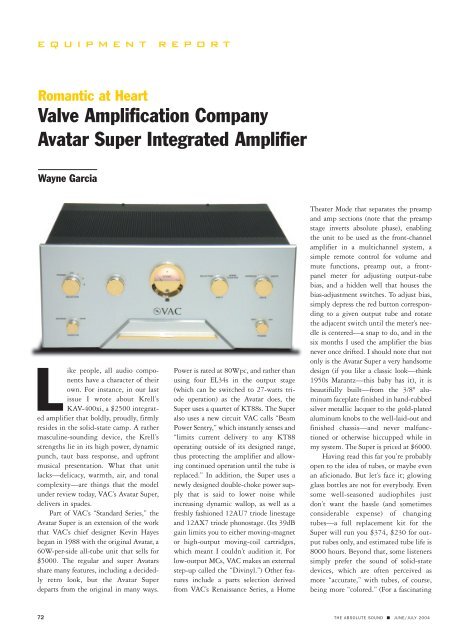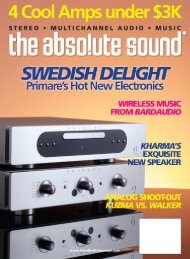Absolute Sound
Absolute Sound
Absolute Sound
Create successful ePaper yourself
Turn your PDF publications into a flip-book with our unique Google optimized e-Paper software.
equipment report<br />
Romantic at Heart<br />
Valve Amplification Company<br />
Avatar Super Integrated Amplifier<br />
Wayne Garcia<br />
Like people, all audio components<br />
have a character of their<br />
own. For instance, in our last<br />
issue I wrote about Krell’s<br />
KAV-400xi, a $2500 integrated<br />
amplifier that boldly, proudly, firmly<br />
resides in the solid-state camp. A rather<br />
masculine-sounding device, the Krell’s<br />
strengths lie in its high power, dynamic<br />
punch, taut bass response, and upfront<br />
musical presentation. What that unit<br />
lacks—delicacy, warmth, air, and tonal<br />
complexity—are things that the model<br />
under review today, VAC’s Avatar Super,<br />
delivers in spades.<br />
Part of VAC’s “Standard Series,” the<br />
Avatar Super is an extension of the work<br />
that VAC’s chief designer Kevin Hayes<br />
began in 1988 with the original Avatar, a<br />
60W-per-side all-tube unit that sells for<br />
$5000. The regular and super Avatars<br />
share many features, including a decidedly<br />
retro look, but the Avatar Super<br />
departs from the original in many ways.<br />
Power is rated at 80Wpc, and rather than<br />
using four EL34s in the output stage<br />
(which can be switched to 27-watts triode<br />
operation) as the Avatar does, the<br />
Super uses a quartet of KT88s. The Super<br />
also uses a new circuit VAC calls “Beam<br />
Power Sentry,” which instantly senses and<br />
“limits current delivery to any KT88<br />
operating outside of its designed range,<br />
thus protecting the amplifier and allowing<br />
continued operation until the tube is<br />
replaced.” In addition, the Super uses a<br />
newly designed double-choke power supply<br />
that is said to lower noise while<br />
increasing dynamic wallop, as well as a<br />
freshly fashioned 12AU7 triode linestage<br />
and 12AX7 triode phonostage. (Its 39dB<br />
gain limits you to either moving-magnet<br />
or high-output moving-coil cartridges,<br />
which meant I couldn’t audition it. For<br />
low-output MCs, VAC makes an external<br />
step-up called the “Divinyl.”) Other features<br />
include a parts selection derived<br />
from VAC’s Renaissance Series, a Home<br />
Theater Mode that separates the preamp<br />
and amp sections (note that the preamp<br />
stage inverts absolute phase), enabling<br />
the unit to be used as the front-channel<br />
amplifier in a multichannel system, a<br />
simple remote control for volume and<br />
mute functions, preamp out, a frontpanel<br />
meter for adjusting output-tube<br />
bias, and a hidden well that houses the<br />
bias-adjustment switches. To adjust bias,<br />
simply depress the red button corresponding<br />
to a given output tube and rotate<br />
the adjacent switch until the meter’s needle<br />
is centered—a snap to do, and in the<br />
six months I used the amplifier the bias<br />
never once drifted. I should note that not<br />
only is the Avatar Super a very handsome<br />
design (if you like a classic look—think<br />
1950s Marantz—this baby has it), it is<br />
beautifully built—from the 3/8" aluminum<br />
faceplate finished in hand-rubbed<br />
silver metallic lacquer to the gold-plated<br />
aluminum knobs to the well-laid-out and<br />
finished chassis—and never malfunctioned<br />
or otherwise hiccupped while in<br />
my system. The Super is priced at $6000.<br />
Having read this far you’re probably<br />
open to the idea of tubes, or maybe even<br />
an aficionado. But let’s face it; glowing<br />
glass bottles are not for everybody. Even<br />
some well-seasoned audiophiles just<br />
don’t want the hassle (and sometimes<br />
considerable expense) of changing<br />
tubes—a full replacement kit for the<br />
Super will run you $374, $230 for output<br />
tubes only, and estimated tube life is<br />
8000 hours. Beyond that, some listeners<br />
simply prefer the sound of solid-state<br />
devices, which are often perceived as<br />
more “accurate,” with tubes, of course,<br />
being more “colored.” (For a fascinating<br />
72 THE ABSOLUTE SOUND ■ JUNE/JULY 2004










